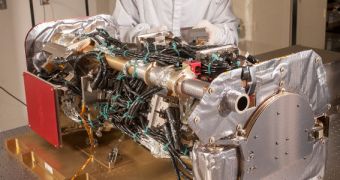Officials with the US National Oceanic and Atmospheric Administration (NOAA) announce that a new instrument for the Geostationary Operational Environmental Satellite – R (GOES-R) has been completed, and is now ready for integration with the rest of the spacecraft.
The instrument, called the Solar Ultra-Violet Imager (SUVI), will conduct studies of the Sun in extreme ultraviolet wavelengths, providing unprecedented, accurate views of the solar disk in this critical portion of the electromagnetic spectrum.
In time, SUVI will help solar physicists gain a better understanding of active regions on the Sun, areas that give birth to solar flares and coronal mass ejections. These space weather phenomena can have ramifications for power grid on Earth, and satellites and astronauts in low orbit.
This instrument is the next-generation replacement of the Solar X-ray Imager (SXI) on other NASA/NOAA GOES spacecraft. Thus far, GOES-R instruments that are ready for installation include the Advanced Baseline Imager (ABI), the Extreme X-Ray Irradiance Sensor (EXIS) and the Space Environment In-Situ Suite (SEISS).

 14 DAY TRIAL //
14 DAY TRIAL //